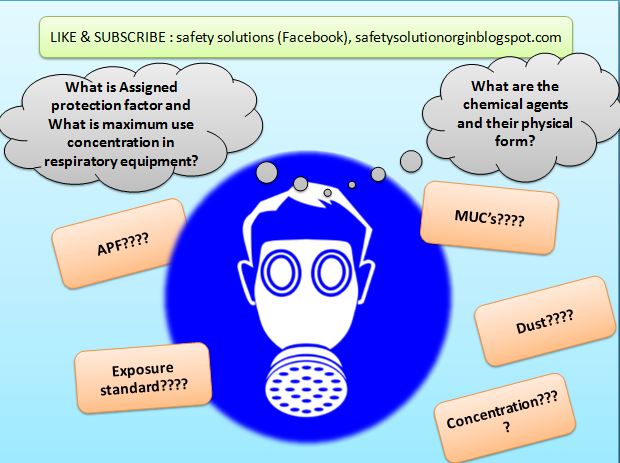What is Assigned
Protection factor in respiratory equipment? How many types of APF from
different respiratory equipment? What is maximum use concentration (MUC’s)?
<
APF helps in selection of right respiratory equipment at
workplace. We need two things permissible exposure limit and workplace concentration.
Divide workplace concentration by exposure limit, result will decide the
required minimum APF.
Example:
Exposure
limit
Permissible Exposure Limit (PEL) for asbestos is 0.1 fiber
per cubic centimeter of air as an eight-hour time-weighted average (TWA), with
an excursion limit (EL) of 1.0 asbestos fibers per cubic centimeter over a
30-minute period. The employer must ensure that no one is exposed above these
limits.
Workplace
concentration
Asbestos
is 0.5 fiber per cubic centimeter of air as an eight-hour time-weighted average
(TWA)
Assigned Protection Factor of Respiratory
= 0.2/0.1
=
5
So,
in this case respiratory having assigned protection factor minimum to 5 can be used.
Maximum Use
Concentration = APF X PEL= 5 X 0.1= 0.5
So here if we
are using APF rating 5 then 0.5 fiber per cubic centimeter will be the maximum
atmospheric concentration of a hazardous substance from which an employee can
be expected to be protected when wearing a respirator.
NOTE:
a-
Whenever the exposures approach the MUC,
then the employer should select the next higher class of respirators for the employees.
b-
Employers must not apply MUCs to conditions
that are immediately dangerous to life or health (IDLH); instead, they must use
respirators listed for IDLH in the standards.
c-
When the calculated MUC exceeds the IDLH
level for a hazardous substance, or the performance limits of the cartridge or
canister, then employers must set the maximum MUC at that lower limit.
d-
Respirator selection should be done based on
the state of workplace agent physical form.
Type of Respirator and their
APF
a- Half
mask/ Dust mask= APF is 10
b- Half
mask (Cartridge based Elastomeric)= APF is 10
c- Full
Face piece= APF is 50
d- Powered
Air-Purifying Respirator (PAPR)= APF is 25
e- Full
Face piece SCABA = APF is 10,000
Definitions:
Assigned Protection Factor (APF)
means the workplace level of respiratory protection that a respirator or class
of respirators is expected to provide to employees when the employer implements
a continuing, effective respiratory protection program.
Maximum Use Concentration (MUC)
means the maximum atmospheric concentration of a hazardous substance from which
an employee can be expected to be protected when wearing a respirator, and is
determined by the assigned protection factor of the respirator or class of
respirators and the exposure limit of the hazardous substance. The MUC usually
can be determined mathematically by multiplying the assigned protection factor
specified for a respirator by the permissible exposure limit (PEL), short-term
exposure limit, ceiling limit, peak limit, or any other exposure limit used for
the hazardous substance.
Respiratory Hazards physical form present
in the workplace is as follows:
Dusts and fibers are solid particles
that are formed or generated from solid materials through mechanical processes
such as crushing, grinding, drilling, abrading or blasting. Examples are lead,
silica, and asbestos.
Fumes are solid particles that are
formed when a metal or other solid vaporizes and the molecules condense (or
solidify) in cool air. Examples are metal fumes from smelting or welding. Fumes
also may be formed from processes such as plastic injection or extrusion
molding.
Mists are tiny droplets of liquid
suspended in the air. Examples are oil mist produced from lubricants used in
metal cutting operations, acid mists from electroplating, and paint spray mist
from spraying operations.
Gases are materials that exist as
individual molecules in the air at room temperature. Examples are welding gases,
such as acetylene and nitrogen, and carbon monoxide produced from internal
combustion engines.
Vapors are the gaseous form of
substances that are normally in the solid or liquid state at room temperature and
pressure. They are formed by evaporation. Most solvents produce vapors.
Examples include toluene and methylene chloride.
Biological hazards include bacteria,
viruses, fungi, and other living organisms that are respirable and can cause
acute and chronic infections. Examples include Legionnaire’s Disease and animal
waste products (e.g., feces).







safety course in chennai
ReplyDeletesafety courses in Chennai
safety training in chennai
safety institute in chennai
iosh course in chennai
fire and safety course in chennai
Respiratory Protection Singapore
ReplyDeleteWelcome to the United Resources, We are specializing in M.R.O Consumables & Equipment, Safety Protective Equipment and Spill Response & Management products and services. We provide the fall protection, respiratory protection and confined space blower equipment in Singapore.
to get more - https://unitedresources-intl.com
Best Article Post!!
ReplyDeleteOnline Banking Courses in India
BSS diploma courses
Safety Diploma Courses
Fire and safety Courses
Industrial safety courses
Safety Courses in india
spill containment pallet Singapore
ReplyDeleteUnited Resources offer best spill mangement project in singapore like Spill Containment pallet Boom to manage spill in visit us now
to get more - https://unitedresources-intl.com/spill-management/